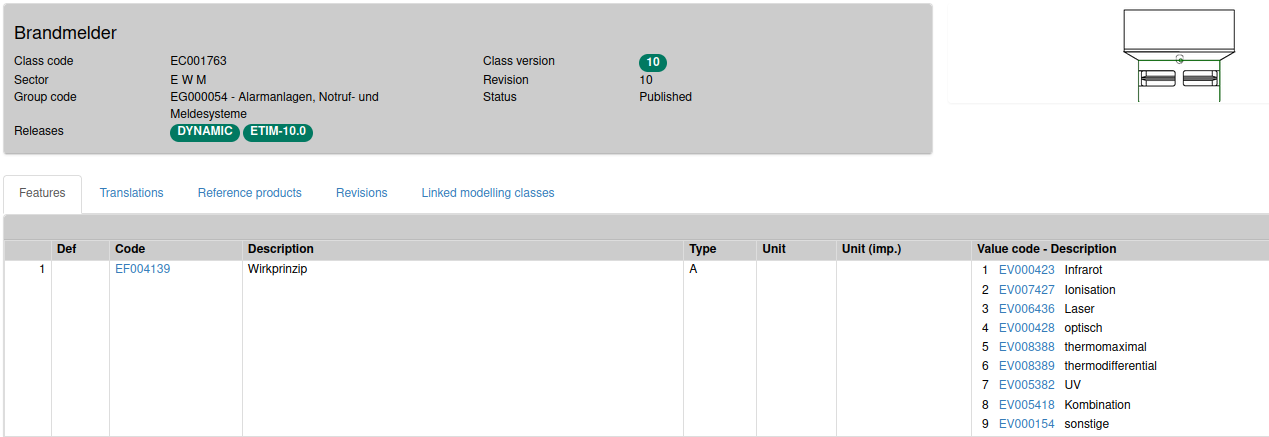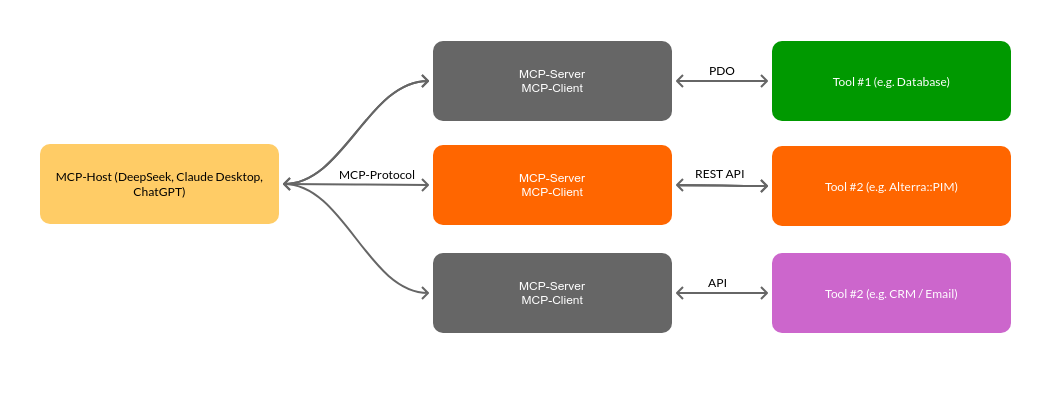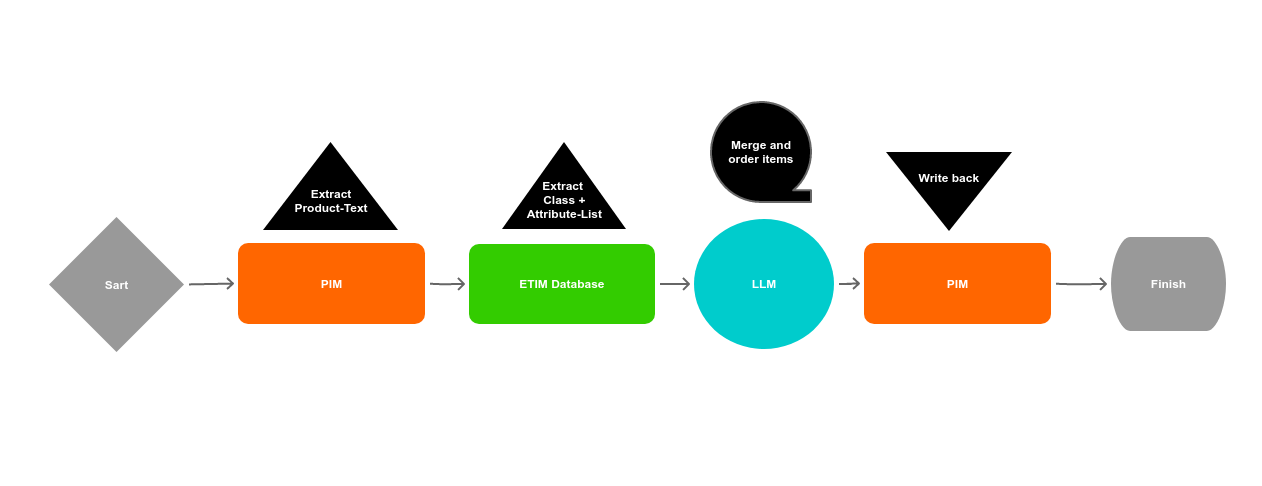Alterra::MCP: How AI agents optimize your product data
AI models can handle text-based input, analyse it, and deliver answers relating to specific questions. Consulting AI instead of traditional search engines is becoming increasingly common. Therefore, business owners may wonder: Can I also use the possibilities of AI productively for my company? One area where a lot of time is spent on text processing is product data management. The questions are: Can AI be a useful aid here?
And if so, how can I use AI to relieve my product data management team?
Depending on the size of the product range, preparing product data can be highly time-consuming. The goal, therefore, is to support employees in specific tasks with the help of AI agents. A typical step in preparing data for technical devices is classification – in other words: assigning technical features to the product. To do so, we often receive a product data sheet or a list of the key technical specifications from the manufacturer. However, these specifications are usually based on criteria that the manufacturer considers important for their product – essentially their USPs.
How should I prepare product information for an eCommerce platform?
The task is to describe the product in a way that makes it suitable for distribution via an eCommerce platform. Simply listing the USPs isn’t enough for this purpose. Instead, the information needs to be structured so the product can be compared with similar products from other manufacturers – just as most eCommerce platform operators would expect. That means we can’t avoid classification standards such as ETIM or eClass.
The product attributes provided by the manufacturer need to be mapped to an ETIM class and its associated properties. If done entirely manually, this process can be very tedious. Especially when the attributes are not clearly structured or are hidden in long, convoluted text descriptions or delivered in an otherwise unstructured format.
Can an AI agent help us find and map product attributes?
This is where we can start by having an AI agent do the heavy lifting. In practice, we provide either the manufacturer’s long-form product description or a link to the product page, then trigger a request to the AI agent. Using that input, the agent performs automatic classification and attribute mapping.
The agent can do two things for me:
- Propose a product class for the item
- Identify the class-relevant attributes directly from the long text and assign them to the product.
The result is structured product data – polished to the point that it can appear as a ready-to-publish technical datasheet on the product page in eCommerce.
Do I need to review the results before they go online?
Of course, employees should review the results before releasing product data as sales texts for online commerce. Ideally, a quick visual check is all that’s needed before publishing. However, keep in mind that the quality of the AI’s text analysis is only as good as the available source data.. For example, if the wrong units of measurement are provided (as, e.g., imperial units instead of metric) it will also be a challenge for the AI. In some cases, technical attributes may be hidden in complex or convoluted long-form text.
More examples of pitfalls when using AI
Let’s take an example that clearly illustrates some of the pitfalls of using AI.
In the product description for a smoke detector, we find the following passage: “The detection principle used in … is known as FLS (Forward Light Scattering). In this process, a laser beam is deflected at a small angle by intruding smoke particles and detected by an optical receiver.”
Now the AI is supposed to perform a classification based on this text. Here are the data available for selection in ECLASS:

Unfortunately, the AI chooses “optical” for the “operating principle”. This is not completely wrong, since the laser is of course monitored using optics.
However, as customer information this is exactly the wrong choice, because the correct “operating principle” would be “laser”, as this is the primary technology. i.e. the decisive principle that defines this measuring device and justifies a completely different, much higher price.
Not completely wrong, but likewise not at all sales-promoting, would be “EV005418 Combination”, which could also be the result of automatic classification depending on the AI used.
In addition, it may well happen that certain attributes are not provided by the manufacturer at all, because they are assumed to be common knowledge within the field. These attributes must then, of course, be added manually.
How great is the savings potential from using AI?
Despite the problem cases mentioned here, you can safely assume that the effort required for product data maintenance will be reduced by at least 50% through the use of AI.
How can I connect the AI agent to my PIM system?
As a rule, the data a product manager is supposed to prepare is kept in a PIM system (see Alterra::PIM). To implement the optimization approach outlined above, we need to connect the AI agent to our PIM system in such a way that it can perform the following steps:
- Retrieve the manufacturer-provided information for a product
- Retrieve the desired target classification system for the product
- Propose a product class
- Identify attributes based on the available properties of the product class
- Assign attributes to the product
- Write back the results as a draft for review and correction/improvement by an employee
What do AI agents and the Model Context Protocol (MCP) have to do with each other?
The Model Context Protocol (MCP) is the standard interface for integrating AI into my local applications. AI is quite good at providing correct answers to a high percentage of queries. But since it is nothing more than mathematical functions, the models are not capable of performing actions on their own.
A language model, by itself, cannot access external database servers or APIs in a meaningful way.
This is exactly the scenario the Model Context Protocol (MCP) was created for. On the one hand, it provides a standard for accessing data, and on the other hand, it allows us to define which function should be executed on that data. The Model Context Protocol defines the open, standardized exchange between the AI host (e.g. ChatGPT or Claude) and my MCP server or the systems behind it.

In our case, we would set up the interface so that the language model service knows where to find the interface, which functions are available there, and which function should be executed. In other words, we integrate the AI service’s “function calling” via the MCP protocol into a procedure that delivers the desired result and then stores it.
With MCP, three actors are involved:
- The language model (e.g., GPT, Claude, or DeepSeek) including its host application
- The MCP server, i.e., the service that provides functions and local data
- The interconnection of the background applications with the model/host via our MCP server
When the model is accessed, the MCP host acts as a client. The MCP host is therefore always an MCP client at the same time. The company operating a language model will provide a function to register our MCP server. In this process, the URL of our MCP server is specified, through which the AI provider learns (via the standardized manifest.json file) what functions and data can be expected from the MCP server. Simply put, this file provides a function description with possible return values and templates for so-called prompts for the AI.
In our case, the MCP server would provide the host with all the necessary pieces of information, essentially as arguments:
Data:
* Here is the manufacturer’s product information text.
* Here is the list of possible classes from ETIM.
* Each class contains the possible properties for a product.
Actions:
* Determine which of the classes is most likely to match the product.
* Traverse the list of properties and find the corresponding values in the given product information text.
* Output the product name, the class, and the properties as the result.
Daten:
* hier ist der Produktionformationstext des Herstellers
* hier ist die Liste der möglichen Klassen aus ETIM
* darin finden sich pro Klasse die möglichen Eigenschaften für ein ProduktAktionen:
* Stelle fest, welche der Klassen mit hoher Wahrscheinlichkeit zum Produkt passt.
* Traversiere die Liste der Eigenschaften und finde im gegebenen Produktionformationstext die passenden Werte zu diesen Eigenschaften.
* Gib als Ergebnis den Produktnamen, die Klasse und die Eigenschaften aus.
Via MCP, AI hosts can read data from local systems, process/optimize it, and write it back. For this purpose, a template or work instruction for the AI is stored in the local MCP service. It is even possible to link processes so that a type of cross-application workflow can be mapped in which differently specialised language models and several internal systems participate.
What functions does Alterra::MCP offer?
Alterra::MCP is the implementation of the standard MCP protocol for the Alterra PIM system. The protocol includes all the functions for Alterra data objects that can already be used via the REST API - i.e. CREATE, READ, UPDATE, DELETE plus the Alterra-specific LINK and UNLINK operations.
In addition, templates can be stored in the MCP server and used to implement AI agents. Building on the example above, an AI host prepared with a ready-made template could handle tasks like these:
- READ: Read a specific product description.
- Identify the relevant values based on a predefined set of attributes.
- UPDATE: Write the identified attributes into the corresponding object field.
- UPDATE: Change the object’s status to “under review”.
- Email: Automatically send an e-mail with a link and review request to the responsible employee.
This shows how easily powerful workflows can be set up – whether fully automated or in seamless collaboration between AI hosts and your team.
What else can AI do with my product data?
Generate product texts with AI
If the product attributes are available in structured form, it’s an easy task for a language generator to create engaging product descriptions – quickly and cost-effectively. Of course, for highly technical products this may not always be the top priority.
Translations powered by AI
Once the results of automatic classification have been reviewed and, if necessary, fine-tuned manually, AI can deliver something it already does quite well: translating product information into many different languages.
Hyper-personalized customer communication
Hyper-personalization is the next level of customer engagement. It uses all available information about a customer to tailor communication with them. While customer data may come from a CRM or a Customer Data Platform, the PIM system provides the product data. This even extends to showing potential customers product images based on the use case of their request – or generating tailored offers that combine up-to-date product and customer data. The content can be adjusted to suit both the target audience and the desired tone of voice.
Automating Digital Asset Management
AI-powered image recognition can automatically categorize assets or suggest alternative text descriptions (alt tags) for images. Since the introduction of the European Accessibility Act (EAA), these have become mandatory to ensure websites are accessible for everyone.
Are there risks for companies in using AI?
Of course, there are also arguments against the widespread adoption of AI in business.
The first concern is security: since AI often acts as an external system, it may need access to sensitive information. This naturally raises questions about data protection and compliance.
A second critical issue is susceptibility to errors. The ability of AI to generate convincing texts quickly and with little effort is tempting – but (current) AI models have an inherent error rate of 20 to 30%. That means the output often sounds good while still being partly inaccurate.
The real challenge is that the generated texts appear well-structured and persuasive, making mistakes considerably harder to spot. Over time, there is also the risk of deskilling employees: as they become more dependent on AI, their ability to think critically and detect errors may diminish.
Finally, today’s AI models come with a serious systemic flaw: when they increasingly consume their own output, the quality of results deteriorates. This phenomenon can be observed after only a few training cycles – leading to what is often described as “hallucinating AI”.
Conclusion
AI makes classifying, creating descriptive texts and translating faster. But your team should never rely blindly on the results. The first step should always be a thorough analysis of your underlying data, assessing whether it is suitable for AI. Take the time to test processes extensively. If you retain the ability to step in and make manual adjustments when needed, the use of AI agents can deliver real, positive impact on your product data management.
Customers
Contact
Sepia GmbH & Co. KG
Ernst-Gnoss-Strasse 22
D-40219 Düsseldorf - Germany
Phone: +49 211 51 419 75
Phone alternative: +49 211 74 958 712 0
E-Mail: info@sepia.de
Looking for consultation or a web demo?
Get it here.
















